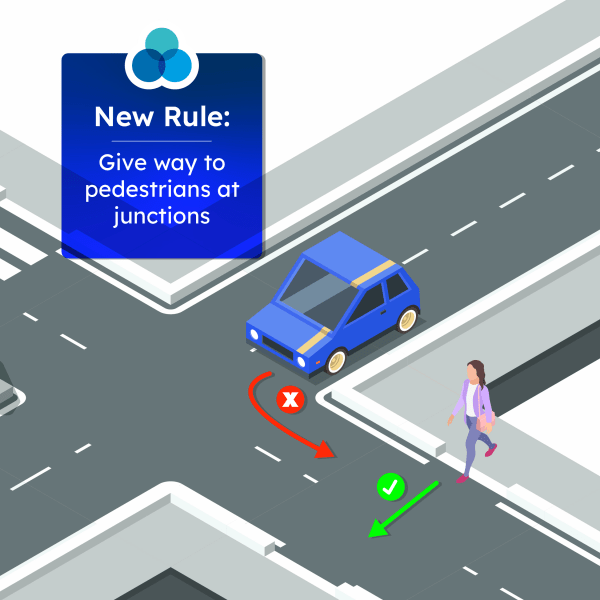What the new Highway Code rules mean for your business
If your business relies on you or other drivers spending significant large periods on the UK roads, a sound knowledge of the Highway Code is essential. The start of 2022 has seen the UK government announce Highway Code changes designed to protect pedestrians, cyclists and those riding animals such as horses or donkeys (riders).
This will impact how commercial drivers operate, particularly in busy city environments. We explain the Highway Code updates and how they will affect you and your business.
(Updated Tue, 5 July 2022)
We have quoted the new Highway Code rules on many occasions in this article, so we have added speech marks for clarity where we have done so.
What are the Highway Code changes?
In total the eight changes are as follows, but only the ones in bold directly have an impact on vehicle drivers:
- An update in the hierarchy of road users, with three new rules around them
- Pedestrians now have the right of way when crossing the road at junctions
- Guidance around the rules on shared walking, riding and cycling spaces
- Guidelines around cyclist’s road position when cycling
- Updates for overtaking cyclists and riders
- Guidance for cyclists at junctions
- Guidance for cyclists at roundabouts
- Updates around parking and charging vehicles

What do the new hierarchy rules mean?
The first change has created an update to the hierarchy based on the risk users face on the roads, putting those most vulnerable at the top to protect them. The rules state:
“Those in charge of vehicles that can cause the greatest harm in the event of a collision bear the greatest responsibility to take care and reduce the danger they pose to others”.
The hierarchy is as follows:
- Pedestrians
- Cyclists
- Horse Riders
- Motorcyclists
- Cars/taxis
- Vans/minibuses
- Large passenger vehicles or courier vehicles like buses and HGVs
Drivers of commercial vehicles will now be more accountable for pedestrians, particularly those driving HGVs. The second change is a big one for drivers too, as you are now legally obliged to allow pedestrians to cross at a junction if you are turning. The rules have been changed for zebra crossings too; pedestrians now have the right of way automatically and not just if they have already started crossing.
The hierarchy also ensures cyclists have priority over all other road users bar pedestrians at junctions too, with drivers having to give way to them if they turn at a junction. The change applies whether they use a cycle lane, cycle track or are ahead on the road. Drivers also need to apply the same rules to riders.
What are the new Highway Code rule changes about cyclists and riders?
Cyclists now have greater allowances on their road position. The Highway Code says they should ride “in the centre of their lane on quiet roads, in slower-moving traffic and at the approach to junctions or road narrowings”. They are also told to keep at least half a metre away from the curb and given clear instruction to “be considerate of the needs of other road users when riding in groups”.
The latter rule change is slightly more positive for drivers, as while they are allowed to ride two abreast, the guidance asks that they be mindful of those behind them. It should make the sight of convoys of cyclists taking up substantial portions of the road a less frequent occurrence. Cyclists are also recommended to give a metre distance when overtaking parked cars in case of opening doors.
The rules around overtaking cyclists have also been tweaked, with drivers needing to give at least 1.5m distance when overtaking if travelling speeds of up to 30mph. If you are travelling quicker, then the distance increases to 2m. Which is the same length distance drivers should keep when overtaking riders or pedestrians in the road, with drivers told to keep to a low speed. If any of this isn’t possible, then you should wait for a better opportunity to overtake.
There are Highway Code updates for cyclists overtaking too, as “people cycling may pass slower-moving or stationary traffic on their right or left”. At roundabouts, cyclists receive right of way, with the rules stating that drivers should “not attempt to overtake people cycling within that person’s lane”.

What are the Highway Code changes about parking and charging?
It’s not quite as significant a change, but the guidance is to follow the ‘Dutch reach’ technique when opening your door after parking. This involves opening the door of your vehicle with the opposite hand to the side it is on, e.g. using the left hand for the driver’s side. Doing so allows you to twist your head and check for oncoming pedestrians and cyclists.
You’re also recommended to be more mindful of other users when charging electric vehicles, ensuring that the cables don’t become a trip hazard for pedestrians by parking as close as possible to the charging point.
Why have the Highway Code updates been made?
The new Highway Code rules have been brought in after lengthy discussions with more than 20,000 road users during 2020. The talks were part of a public consultation that set out to improve the road safety of pedestrians, cyclists and riders.
You can read the full report here, but it weighs in at a whopping 67 pages.
What do they mean for businesses that use vehicles and fleets?
The new rules around junctions will undoubtedly cause the most issues for drivers. It will slow journeys down, and you will need to be much more aware of pedestrians at junctions to ensure you stay within the guidelines.
More importantly, while the new Highway Code rules are intended to protect pedestrians, there’s a chance that in the short term at least, it could lead to more incidents. Drivers unaware of the changes may take less care with pedestrians walking out into busy roads, resulting in the chances of hitting pedestrians or collisions arising from drivers swerving to avoid oncoming walkers.
While the other Highway Code updates are less likely to lead to serious incidents, your drivers must be aware of and prepared for them.
What’s the reaction been like?
The chief concern relates to the rules on pedestrians crossing and cyclist road positions, which predictably hasn’t gone down well with drivers.
The AA’s president, Edmund King, voiced his concerns of increased collisions when speaking to the press association, echoed by Voters for Motors who spoke to MailOnline. The Express has reported that FairFuelUK Campaign, the Alliance of British Drivers and the Motorcycle Action Group have all written to Transport Secretary Grant Shapps outlining their frustration with the changes.
Whether or not these voices will amount to any change in the rules remains to be seen. For now, we reiterate how important it is to ensure you and your drivers are aware of the impact of the rules.



